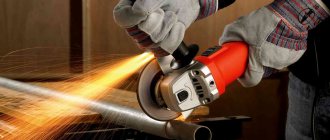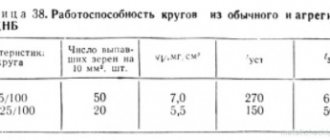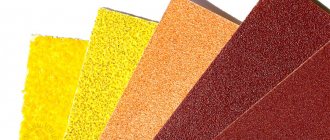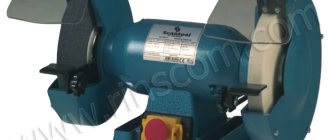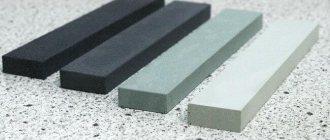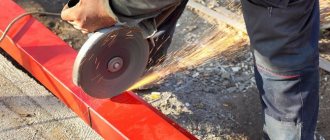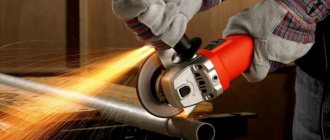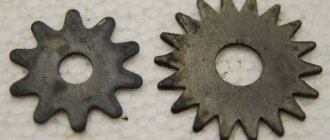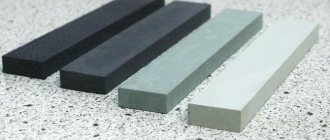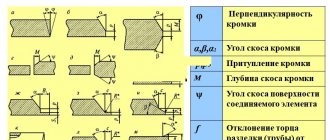The variety of work performed with the help of grinders is largely ensured by the wide range of tools that work with them.
For each standard size angle grinder, you can always select consumables that correspond to the characteristics and dimensions. One of the parameters that determines the capabilities of an angle grinder is the maximum diameter of the disk that is installed on it. It determines the speed, engine power and torque. The choice of disk size is closely related to the nature of the work performed by the grinder.
Types of circles
The circles (disks) of grinders differ according to the following indicators:
- work performed that determines the purpose of the tool;
- composition of the material;
- dimensions.
Technological features
The necessary processing technology is provided by the following consumables.
- — Cutting wheels. Mainly used for processing metals, less often for other types of materials.
- — Grinding wheels. Different designs allow you to perform both roughing or cleaning, and bringing the surface roughness to the desired condition.
- — Polishing discs and attachments. Bring the surface to a shine using felt or other fabric with similar properties.
By material
The operating modes are influenced by the material component from which the tool is made.
- — Abrasive disc. The basis that served for the manufacture of the tool is the abrasive material itself, a binder, for example, bakelite and various fillers. Mainly used for metal processing.
- — Diamond wheel (with diamond coating). With its help, you can process materials of any strength (various types of stone, ceramics, quartz glass and many other similar ones consisting of solid fractions).
Dimensions
The main classification criterion here is the diameter of the disc. The depth of the cut depends on its size (it is approximately a quarter of the diameter). The functionality of an angle grinder is determined by the size of the tool: a small diameter makes it possible to process a light angle grinder in hard-to-reach places, while a larger size angle grinder with greater productivity will be difficult and unsafe to hold “in weight”.
Types of discs for grinders
Grinder circles are replaceable elements. When working with different materials, you need to understand their types. This will help to perform the necessary operation efficiently. Circles are classified according to the following parameters:
- by appointment;
- type of work performed;
- design;
- type of cutting;
- material of manufacture;
- sizes.
Depending on their purpose, there are attachments for working on metal, wood, stone, concrete, marble, etc. Manufacturers indicate the purpose in the marking, which is applied directly to the product itself. Many varieties are universal tools, suitable for processing several types of materials.
Based on the type of work performed, as indicated in the title, manufacturers produce the following attachments for angle grinders:
- stripping (metal brushes, end flap wheels, with mandrel, batch);
- roughing (grinding wheels, twisted cutters, diamond roughing wheels);
- saws The presence of teeth on the cutting edge is a design feature of the product. This allows you to obtain particularly clean cuts on wood, plasterboard, gas silicate, plywood and other similar materials;
- cut-off Cutting and diamond discs are produced with a continuous cutting edge and divided into segments;
- grinding (discs with varying degrees of grain size and hardness);
- polishing (felt, felt, with special Velcro and grinding attachments);
- for cutting joints in asphalt, concrete, etc.;
- milling (for cutting grooves, bowls, edge processing, etc.);
- sharpening A characteristic feature is the ability to perform operations with the side surface.
The disk is a product of a certain diameter and thickness, which has a mounting hole for attachment to an angle grinder with a cutting edge of a solid, segmented or shaped configuration.
The choice of a specific type depends on the operation being performed and the material on which it will be performed. Cutting using such attachments can be done dry, wet or combined. The labeling indicates this feature. Depending on the material used, the discs can be abrasive, carbide, diamond or brush. The basis of the first type of circles is special latex paper or fiber, onto which an abrasive layer with a binder is applied. The nozzle, made of fiber, comes with a rubber or plastic support plate. Carbide disc is a product made of alloy steel. Such consumables can be used for cutting aluminum, stainless steel, high carbon steel and other materials, as indicated in the marking.
Diamond blades are a universal consumable. It is a steel product with diamond coating applied to its surface. This allows you to get the thinnest cut in any material. Popular products, popularly called turtles, are a type of attachment made on a flexible base, have a grooved structure and are attached with Velcro. In addition, they produce diamond blades with a solid edge for cutting in the wet method, segmented and turbo-segmented for cutting in the dry method, and combined ones.
Marking
The choice of the right tool is facilitated by the presence of markings. It contains the technical parameters of consumables in encrypted form. For example, this is what an alphanumeric set of markings for a cutting disc looks like, produced by a Russian manufacturer:
- — The image shows the tool manufacturer — Luga Abrasive Plant (Luga, Leningrad Region).
- — Tool name:
- cutting wheel - in Russian;
- cut –off – wheel – in English translation.
- — Purpose: for processing steel (inscriptions “steel”, “steel” on the circle).
- — The dimensions of the circle are indicated (outer diameter x thickness x bore diameter):
- in mm – 200 x 2.5 x 22.23;
- in inches – 8”x 1/10”x 7/8”;
- digital designation "41". This is a characteristic of the design of the circle - here it is flat.
- — The circle is designed for 7650 rpm, while the maximum peripheral speed should not exceed 80 m/s.
- — Technical parameters of the wheel material are determined from the designation “A 30 S BF”, where:
- A – means that the abrasive is based on white electrocorundum, which is specifically used for metal processing;
- 30 – abrasive grain size, here it is average;
- S – hardness of the circle, here the circle is hard;
- BF - denotes the type of bond, here synthetic resins with glass fiber reinforcement.
- — Rules for safe work in the form of signs indicating the required action.
- - GOST 21963 - 2002, GOST R 52588 - 2011, EN 12413 - Russian and European regulatory documents to which this tool complies.
The marking of a foreign manufacturer of tools for angle grinders is as follows:
- — Tools under the NORTON VULKAN brand are produced by the Saint Gobain corporation, headquartered in France.
- —The purpose of the cutting disc (the company produces only such a tool for angle grinders) for processing steel (in addition, for visualization purposes, the label for wheels intended for metal processing is blue) is duplicated in several languages.
- — The circle is designed for 12250 rpm with a maximum peripheral speed of 80 m/s.
- — The dimensions are the same as on the Russian disk - in mm and inches.
- — The digital designation “41” has been added to the technical parameters of “A60S – BF41”. This is a characteristic of the design of the circle - here it is flat.
- — Methods of safe work must be indicated.
- — The regulatory documents to which the instrument complies are issued by the European Union.
What are the sizes of wheels for angle grinders Bosch, Interskol and more?
Almost all large companies produce grinders covering the maximum number of works - from household to industrial designs. Each type has its own tool size. In addition to the production of angle grinders, such manufacturers (Bosch, Metabo, Interskol and others) have mastered the parallel production of consumables. They select a special composition and standard size of consumables in order to maximize the operating efficiency of the specific model they produce.
Outer and bore diameter, maximum and minimum value
The most popular range of angle grinder sizes consists of the following values.
External diameter . The most preferred sizes are: 115 mm, 125 mm, 150 mm, 180 mm, 200 mm and 230 mm. In rare cases, to perform, for example, jewelry work with small parts, portable battery-powered angle grinders with diameters of 76 mm or 100 mm are used.
The minimum diameter of 115 mm is used for simple work in the form of processing hard-to-reach surfaces in the household. Anglers with a circle with a diameter of 125 mm have greater ability to perform various household works.
The diameter of 230 mm is used in the professional context of angle grinders for large volumes of work, for example, in construction. Circles with a diameter of more than 230 mm are installed on stationary equipment.
Thickness _ Cutting wheels are available in thicknesses from 0.8 mm to 5.0 mm. Moreover, a larger diameter should have a circle with a correspondingly greater thickness.
You should know! A thin disc is easy to cut, but it is also more likely to break.
Landing diameter . The standard mounting diameter for angle grinder consumables is 22.23 mm. In the vast majority of cases, it is the same for all disk sizes. It is rare to find mounting diameters of 10 mm, 13 mm, 16 mm due to the limited use of angle grinders with a diameter smaller than 100 mm. A 32 mm bore diameter is used with circles of 300 mm and larger on stationary equipment.
Types of cutting wheels
The main criterion used to categorize cutting discs is the type of material they work most effectively with. In accordance with this feature, circles are:
- on metal. Area of use: cutting sheet metal, U-shaped profiles - channels, L-shaped beams - angles, pipes, including profiles, and fittings;
- on wood. Along the perimeter of the outer edge of the circle there are sharp straight, beveled, trapezoidal and other shaped teeth. Discs of this type are also used for cutting MDF panels, plasterboard sheets, double-glazed window elements and pipes made of plastic;
- on stone. They are used for cutting flat and corrugated asbestos-cement sheets, paving stones, stone structures that can withstand heavy loads of paving slabs, as well as objects made of concrete and sand-lime brick (see figure).
Another criterion used to classify cutting discs for angle grinders is their production technology.
Abrasive discs. The structural basis of such a circle is made up of at least 2 layers of the so-called. fiberglass mesh, and a mass including abrasive materials is applied on top of it. These could be:
- electrocorundum This is a super-hard, resistant to chemically aggressive environments and fire-resistant material, which is based on aluminum oxide A2O3;
- silicon carbide. Chemical inorganic binary compound of the elements carbon (C) and silicon (Si);
- corundum. The most common is zirconium corundum (ZrO2+A2O3 alloy). It is characterized by hardness, density and, at the same time, significant viscosity.
The technology for manufacturing discs intended for cutting metal objects involves heat treatment. After passing this stage, the product acquires increased resistance to destructive loads. There are two types of abrasive consumables/materials based on configuration. These are the disks:
- concave (more precisely, their seat sleeve is concave);
- flat.
Diamond discs. Used for cutting objects made from materials characterized by increased strength:
- natural/natural stone;
- asphalt pavement;
- non-slit red brick of grades M300, M250 and M200;
- marble, including artificial;
- fine-grained granite - the most durable of all types of this rock;
- concrete of all common grades - B40, B30, B25, B20, B15, etc.
Made from steel. The end surface of the disk is covered with particles of abrasive mass. They represent diamond chips. The range of variation of the width (S) of the diamond-containing layer is as follows: 1.50 mm ≤S≤ 3.0 mm.
Three types of diamond-containing cutting wheels are supplied to the market:
- segmented. The cutting edge with an abrasive mass applied to it is a collection of individual segments. Using a consumable tool of this type, dry cutting is carried out;
- solid. Structurally, it is made in the form of a monolithic disk with a continuous diamond abrasive edge. Designed for dry cutting;
- Turbo disc. The configuration of its diamond-containing edge resembles a wave with inclined grooves. Their presence reduces the area of contact with the processed material. This design solution ensures that the cooling process occurs naturally. The disk is essentially universal. Used for both types of cutting: dry and with coolant.
For large, medium and small angle grinders
The power classification into small, medium and large is closely related to dimensions and weight. The greater the power, the greater the weight and overall dimensions.
So, for example, grinders with disks of 115 mm - 125 mm and a power of 0.6 kW to 1.2 kW are classified as small equipment.
Angler grinders with discs of 150 mm - 180 mm and a power of up to 2.0 kW belong to the middle class of such equipment.
Professional angle grinders with a power of up to 3.0 kW and a disc diameter of 230 mm conventionally belong to large angle grinders.
Thickness of cutting discs
It must be said right away that the thickness of cutting wheels is not standardized. The value of this parameter depends on their outer diameter. Below are the most commonly found numbers on the market that display the thickness of the discs (S) with outer diameters:
- 230.0 mm. 1.60 ≤S ≤ 4.0 mm;
- 180.0 mm. 1.0 ≤S ≤ 4.0 mm;
- 150.0 mm. 0.8 ≤S ≤ 3.20 mm;
- 125.0 mm. 0.8 ≤S ≤ 3.20 mm;
- 115.0 mm. 1.0 ≤S≤ 3.20 mm.
It is rational to use discs with a small thickness in conjunction with low-power angle grinders. The lower the value of parameter S, the faster and easier the cutting occurs. The reason for this phenomenon is obvious: the level of resistance of materials is lower. Working with a thick disk will require great physical effort from the performer. The figure shows the layer-by-layer structure of a conventional cutting wheel. Studying it will help you find out which elements combine to ultimately form the thickness of such a product.
For metal, concrete, wood and other materials
To effectively process any material, it is important to choose the right power so that it matches the diameter of the tool and its thickness. In addition, the consumable must have suitable characteristics for processing a specific type of workpiece material.
The main difference between discs for steel, cast iron, and non-ferrous metals is in the composition of the fillers. To process alloy steels, a very strong additive is added to the disc material that can overcome the resistance of alloy steel. When processing non-ferrous metals, on the contrary, a soft filler is added, which works effectively when processing viscous materials.
Disc for aluminum
To process concrete (tiles, paving slabs), diamond discs are used (actually, these are metal circles coated with diamond).
Tile disc
It is not recommended to process wood with an angle grinder due to the high risk of injury. If such a need nevertheless arises, then the best option would be a grinder with a disk with a diameter of 125 mm. As a working tool, special angle grinder discs for wood should be used.
Wood disc
Wood discs
Toothed or circular discs are installed on permanently mounted “grinders.” A special feature of such a disc is the presence of teeth on the outside tipped with carbide materials.
There are chain discs, they have a chain. Suitable for medium density wood. When working with such a wheel, you cannot cut wood with metal elements; the chain will quickly become dull when it comes into contact with them. Everything is like with saws.
Sometimes you need a blade that can cut all types of materials - this is a universal blade. The nozzle has the appearance of a regular disk with three additional teeth, tipped with hard metal.
The disc with a tungsten carbide edge has tungsten carbide coating on the outside. There are technological holes on the disk, they help remove heat during operation. This disc is suitable for wood and plastic. Working with such a disk makes it easier to encounter various metal objects, such as screws.
How to choose
The main criterion for choosing the disk size will be the nature of the work performed. In the household, these will be circles of smaller diameters; in a production environment, a tool of large diameter (230 mm) is used.
In addition to the dimensional characteristics, you should carefully check the compliance of the disc material with the material of the workpiece being processed.
Another determining factor is the power of the grinder. It is directly related to the weight and overall characteristics of an angle grinder. With approximately the same characteristics, preference should be given to a lighter specimen.
DO NOT ATTEMPT TO CUT WITH A SANDING DISC OR GRIND WITH A CUT-OFF DISC
An angle grinder solves a wide range of problems, and each type of disk or attachment has its own purpose. Each one says what material it is intended for, its dimensions and maximum speed.
If you try to use, for example, a cutting wheel for grinding or vice versa, you risk breaking it, and numerous fragments can cause serious injury to you and those around you. An angle grinder is a rather dangerous tool and requires compliance with safety precautions.
Source
How to replace
The grinder disc is a consumable item. Therefore, it has to be changed frequently. There is a simple algorithm in which an important role is played by the original design of the key supplied to the consumer along with the grinder.
- — The protruding rods of a special key are installed in the grooves of the fastening nut.
- — At the same time, press the lock button located on the gearbox housing. It will lock the rotor from turning.
- — Turn the key counterclockwise to release the fasteners of the worn disk.
- — The old disk is replaced with a new one of the same technical characteristics and size. The new disk is installed with the markings facing out to remind you of the disk parameters and for other good reasons (see explanation in the video above).
- — The fastening nut is first tightened by hand and finally tightened with a special wrench.
The Bulgarian is ready to continue fulfilling its functional purpose.
